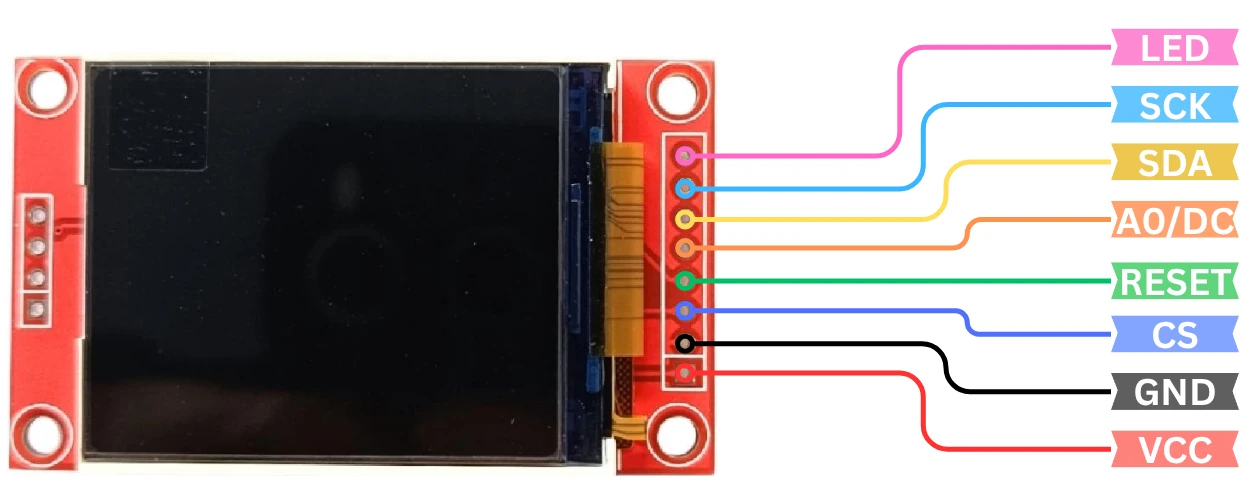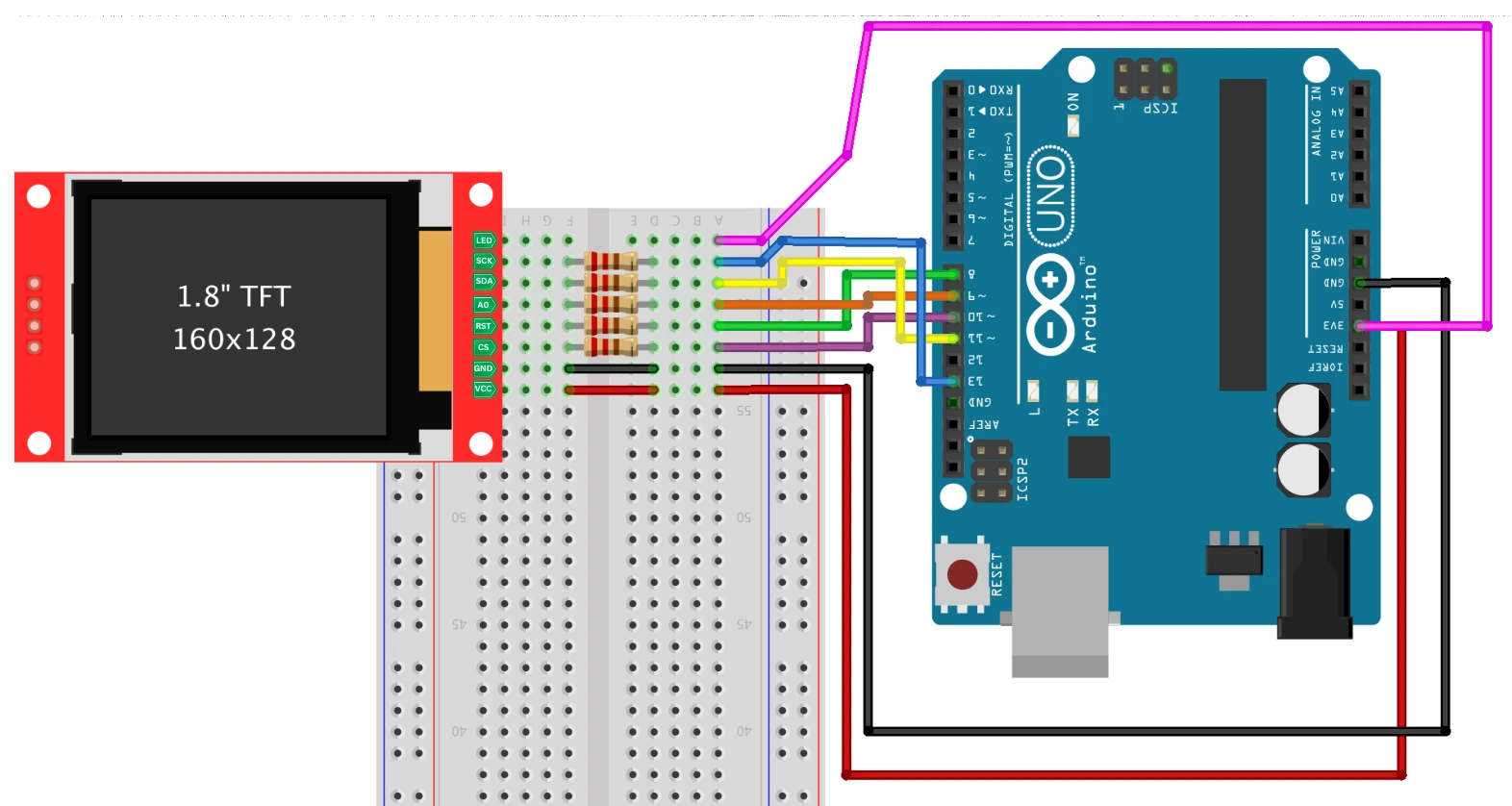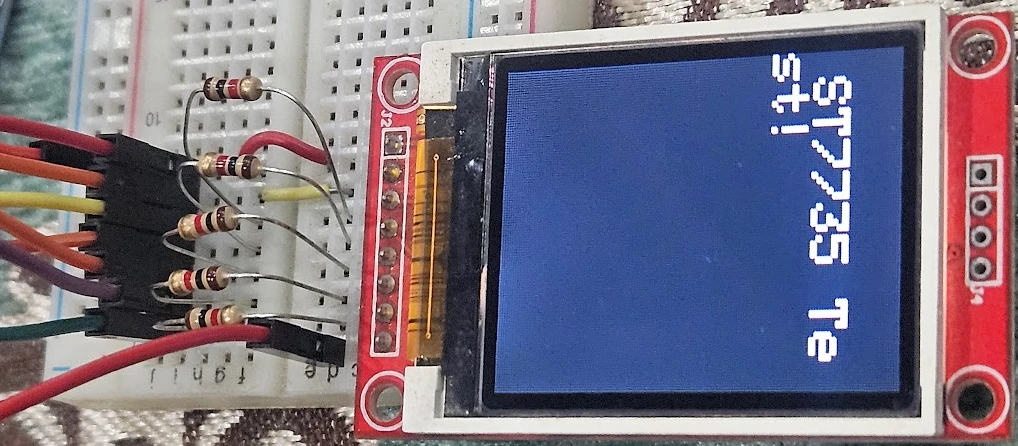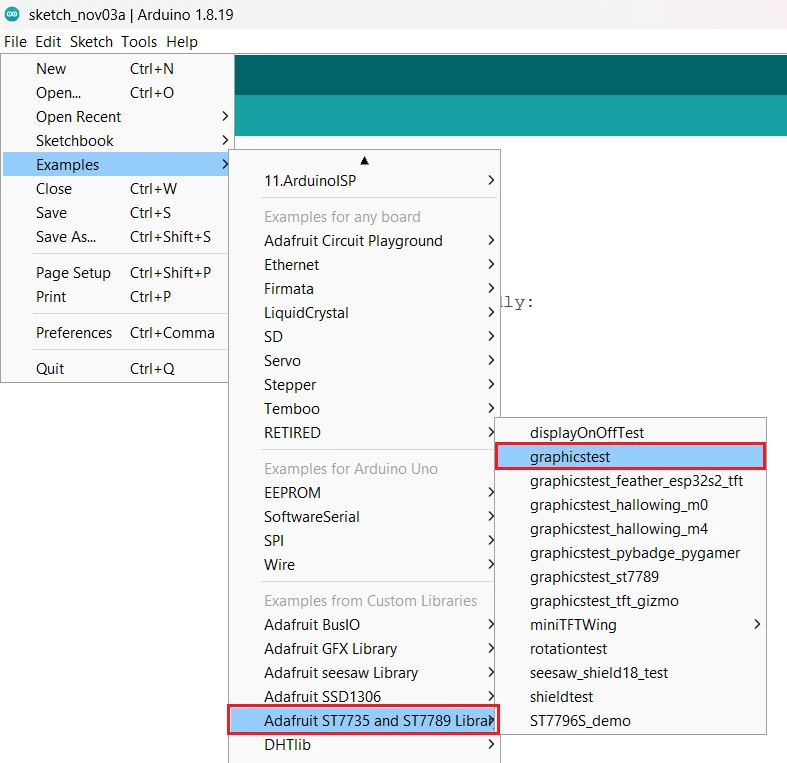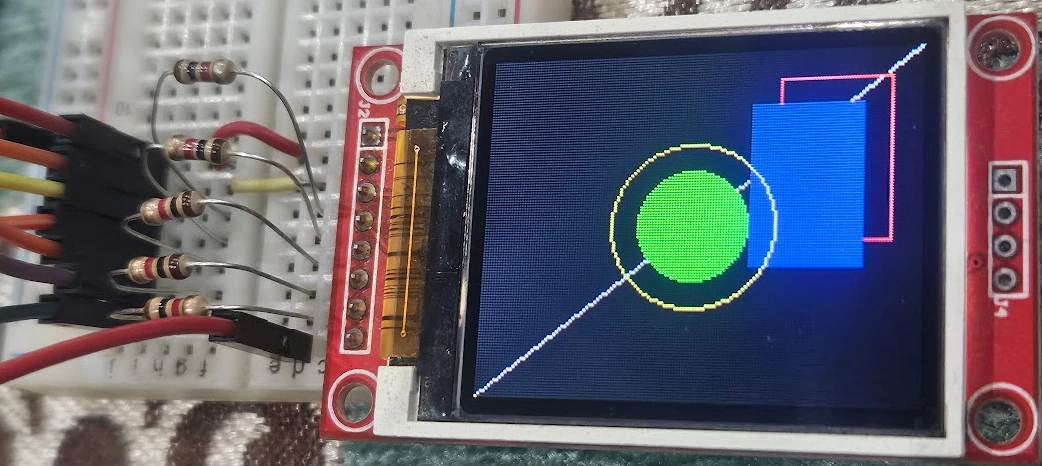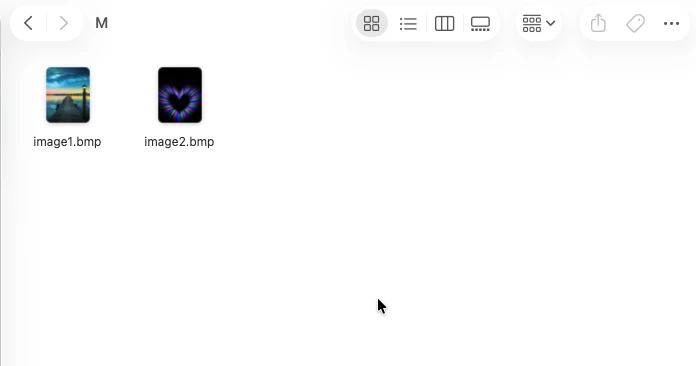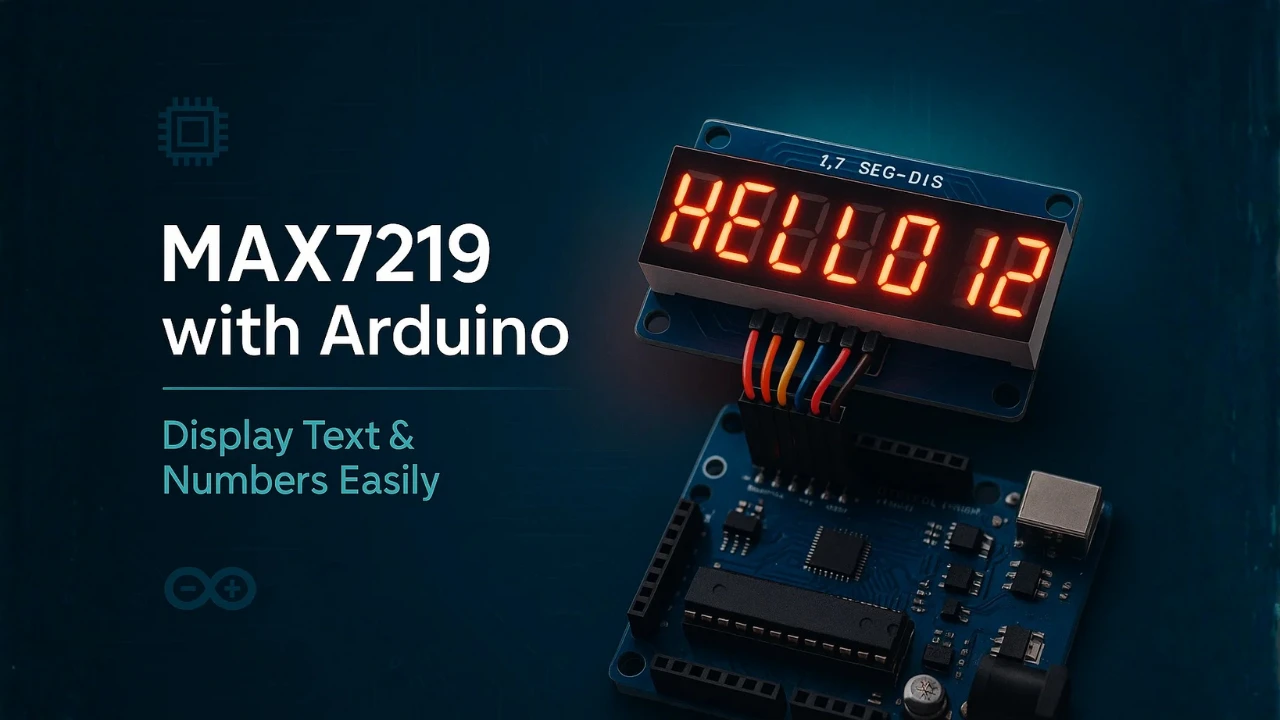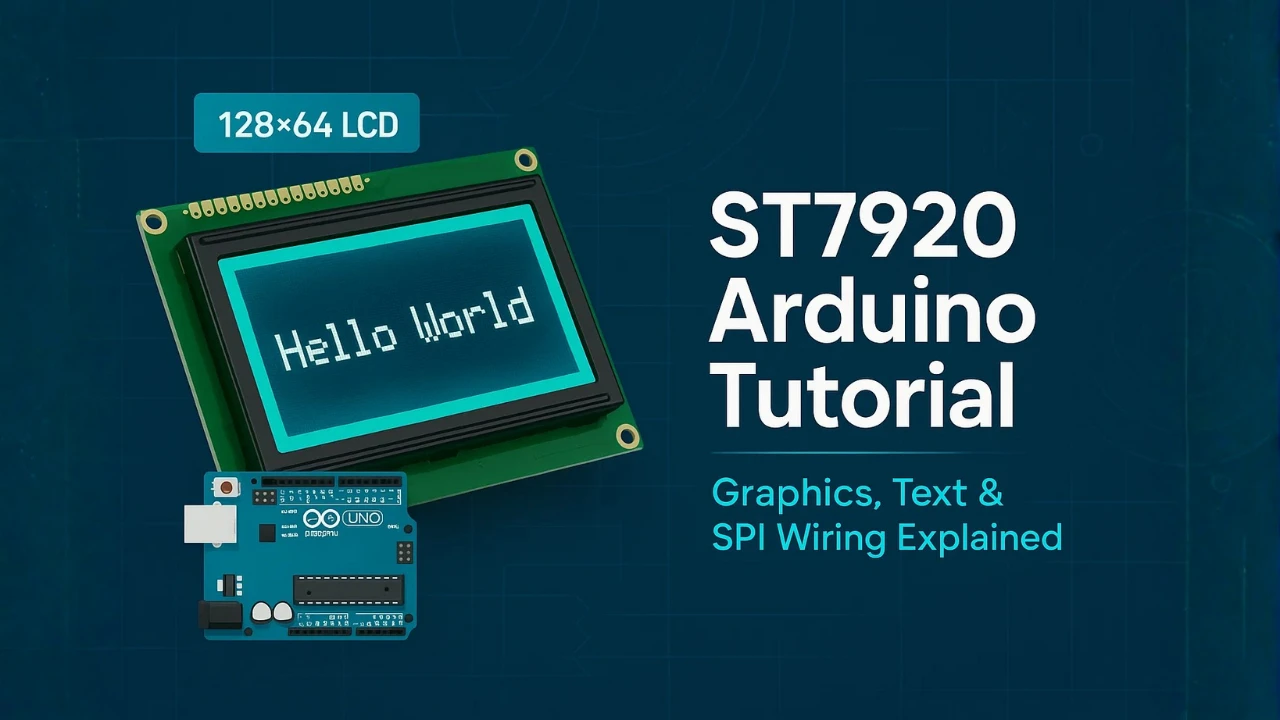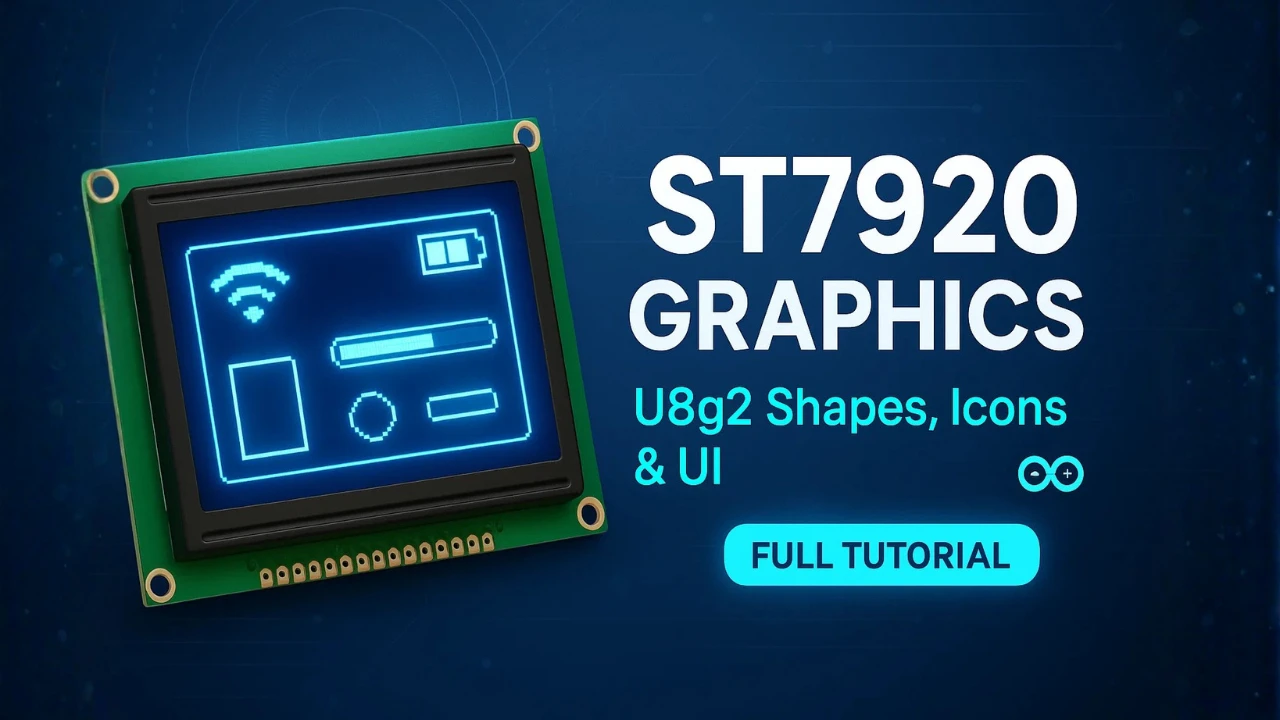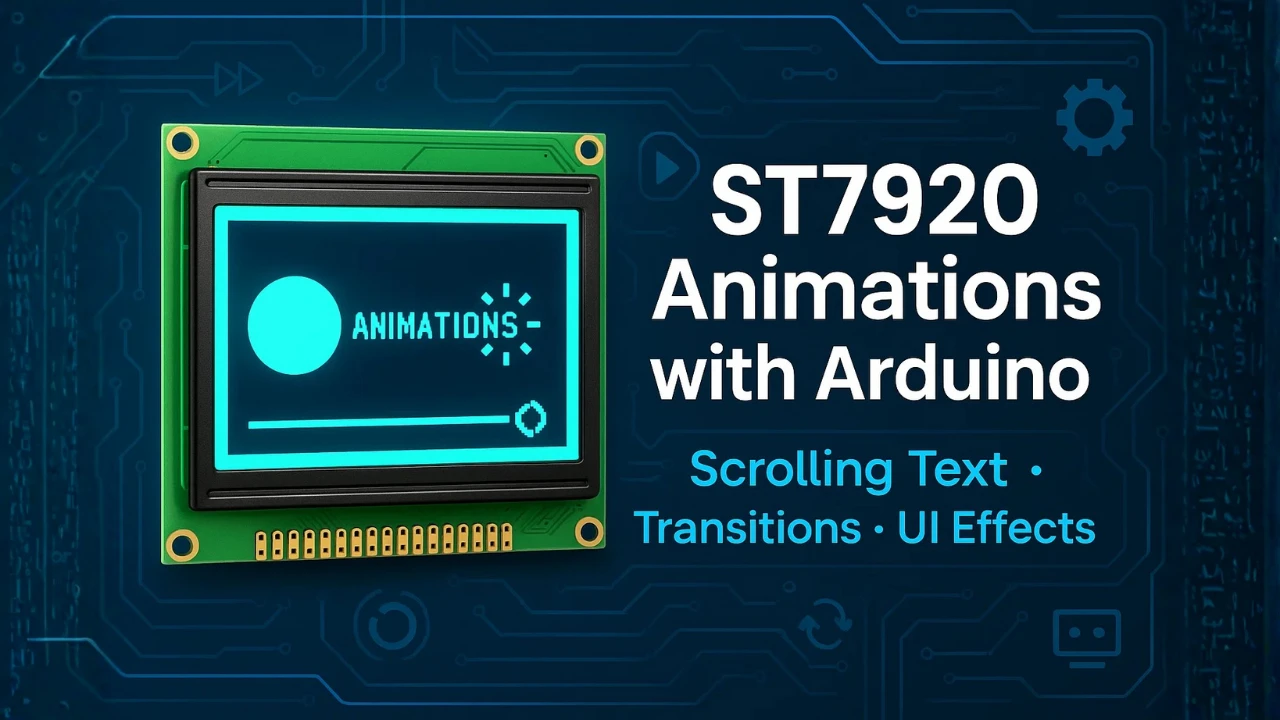How to Interface ST7735 TFT Display with Arduino (With SD Card Image Display)
The ST7735 TFT display is a bright and colorful 1.8-inch screen that works perfectly with Arduino boards. It’s based on the ST7735 driver IC and uses the SPI interface, which makes it both fast and easy to connect. With this small display, you can show text, draw shapes, or even load real images directly from an SD card.
In this tutorial, we’ll learn how to interface the ST7735 display with Arduino step by step. We’ll start with wiring and setup, move on to displaying text and graphics, and finally, we’ll show how to display images from an SD card on the ST7735 screen.
If you’re new to SD cards with Arduino, check out our detailed guide here:
Interface SD Card with Arduino using SPI
By the end of this post, you’ll be able to use your ST7735 as a mini-display for your Arduino projects, perfect for IoT dashboards, small games, or sensor data visualization.

Introduction to ST7735 TFT Display
What is the ST7735 Display
The 1.8-inch ST7735 TFT display is a small, full-color screen that’s widely used in Arduino projects and other embedded systems. It uses the ST7735 driver IC, which controls the display through the SPI communication interface — allowing fast data transfer between the Arduino and the screen.
This 1.8-inch TFT module offers a resolution of 128×160 pixels, providing a clear and colourful output for its size. It can display up to 65,000 colors (16-bit color depth), which makes it suitable for showing not only text and shapes but also small bitmap images or icons.
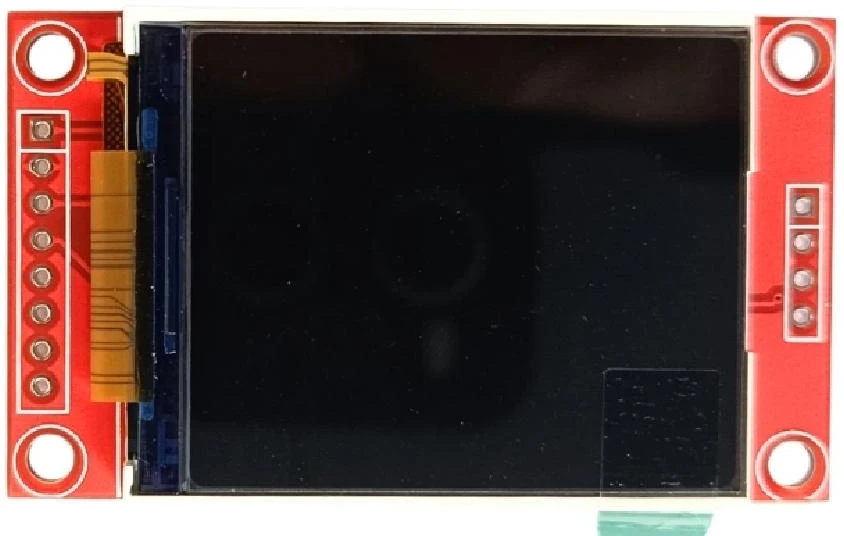
Although the display works on 3.3V logic, it can easily interface with 5V Arduino boards such as the Uno, Nano, or Mega using proper level shifting or resistor dividers. Its compact design and low power usage make it ideal for portable or handheld projects.
ST7735 Specifications and Features
Here are the main specifications and key features of the 1.8-inch ST7735 TFT display:
- Display Size: 1.8 inches (diagonal)
- Resolution: 128 × 160 pixels
- Driver IC: ST7735
- Interface: SPI (Serial Peripheral Interface)
- Color Depth: 16-bit (65K colors)
- Operating Voltage: 3.3V (some modules include a 5V-compatible regulator)
- Backlight: Built-in white LED
- Viewing Angle: Up to 160° (for IPS variants)
- Refresh Rate: Suitable for smooth animations and graphics
- Compact Size: Lightweight and easy to mount on breadboards or small enclosures
This module combines bright color output, simple wiring, and low power consumption, which makes it one of the most popular small TFT screens for Arduino users. It’s powerful enough to show sensor data, graphs, menus, or even small images from an SD card.
Why Use ST7735 with Arduino
The 1.8-inch ST7735 TFT is an excellent choice for Arduino projects because of its SPI interface, great color quality, and readily available libraries. It allows beginners and advanced users alike to add graphics and color displays to their projects without much effort.
Here’s why the 1.8-inch ST7735 works so well with Arduino:
- Simple SPI wiring – requires only a few pins for communication.
- Vibrant 16-bit color display – ideal for text, gauges, and icons.
- Compact and affordable – fits perfectly in small projects.
- Fully supported by Adafruit’s ST7735 and GFX libraries, making coding straightforward.
- Compatible with popular Arduino boards like Uno, Nano, and Mega.
This display is great for IoT dashboards, mini game consoles, sensor monitors, and any project where you want to make your Arduino output visually appealing. Later in this tutorial, we’ll also explore how to display BMP images directly from an SD card, giving you even more creative options.
ST7735 Pinout and Connection with Arduino
Let’s start with the ST7735 Pin description first.
ST7735 Pin Description
The 1.8-inch ST7735 TFT display communicates with the Arduino using the SPI interface, which makes wiring simple and efficient. Different modules may have slight variations in labeling, but most ST7735 displays include the following pins:
| Pin Name | Description |
|---|---|
| GND | Ground connection (connects to Arduino GND). |
| VCC | Power supply pin. Usually 3.3V, but some modules include a regulator and can accept 5V. |
| SCL (CLK) | Serial Clock pin. Used to synchronize data transfer between Arduino and display. |
| SDA (MOSI) | Serial Data input pin. Carries display data from Arduino to the ST7735. |
| RES (RESET) | Resets the display when pulled LOW. Helps initialize the display during startup. |
| DC (A0) | Data/Command control pin. Tells the display whether data or a command is being sent. |
| CS | Chip Select pin. Enables or disables communication with the display. Active LOW. |
| BL (LED) | Controls the display backlight. Connect to 3.3V (or 5V if supported) for constant brightness, or to a PWM pin for dimming. |
Note: Some ST7735 modules also include pins like MISO or SD_CS if they have an onboard SD card slot. These are not used for the basic display connection but will be important later when we display images from the SD card.
ST7735 Arduino Connection Diagram
To connect the 1.8-inch ST7735 display to an Arduino Uno or Nano, we’ll use the SPI pins. The SPI pins on different Arduino boards may vary slightly, but for Uno and Nano, they are fixed at pins 11 (MOSI), 13 (SCK), and 10 (SS).
The image below shows the connection between Arduino UNO and ST7735 LCD display.
Here’s the connection table:
| ST7735 Pin | Arduino Uno/Nano Pin | Description |
|---|---|---|
| VCC | 5V (or 3.3V if your module doesn’t have a regulator) | Power supply for the display |
| GND | GND | Common ground |
| SCL (CLK) | D13 | SPI Clock |
| SDA (MOSI) | D11 | SPI Data from Arduino to Display |
| RES (RESET) | D8 | Reset control pin |
| DC (A0) | D9 | Data/Command selection |
| CS | D10 | Chip Select pin |
| BL (LED) | 3.3V or D6 (PWM optional) | Backlight control |
Tip: Always check your module’s specifications. Some displays have onboard level shifters, but if yours doesn’t, use a voltage divider on the SPI lines to protect the 3.3V logic display from 5V signals.
Wiring ST7735 in SPI Mode
The ST7735 uses SPI (Serial Peripheral Interface) for communication. In this mode, the Arduino acts as the master, and the display acts as the slave. SPI is fast and reliable, making it perfect for transferring display data like pixels, colors, and bitmaps.
Here’s how the SPI wiring works:
- SCL (Clock) synchronizes communication between Arduino and the display.
- SDA (MOSI) sends pixel and command data from Arduino to the display controller.
- CS selects the ST7735 device so multiple SPI devices can share the same bus.
- DC defines whether the incoming byte is a command (LOW) or data (HIGH).
- RESET ensures the display starts in a known state.
For stable performance:
- Keep the SPI wires short to reduce noise.
- Ensure the display is properly powered (preferably from a regulated 3.3V pin).
- If the display flickers or shows distorted colors, lower the SPI speed slightly in your code.
Once the wiring is done correctly, you can move on to setting up the Arduino IDE and libraries to communicate with the display smoothly.
Setting Up Arduino IDE for ST7735
Before we start displaying text, graphics, or images on the 1.8-inch ST7735 TFT display, we need to set up the Arduino IDE properly. The setup includes installing the right libraries, running a basic test code, and verifying that the display is working as expected.
Installing Adafruit ST7735 and GFX Libraries
The easiest way to use the ST7735 display with Arduino is through the Adafruit ST7735 and Adafruit GFX libraries. These libraries handle all the low-level communication with the display and make it easy to draw text, shapes, and bitmaps.
Here’s how to install them:
- Open Arduino IDE on your computer.
- Go to Sketch → Include Library → Manage Libraries…
- In the Library Manager, type “Adafruit ST7735” in the search bar.
- Install the “Adafruit ST7735 and ST7789 Library” by Adafruit.
- Next, search for “Adafruit GFX Library” and install it as well.
Once installed, you’ll find several example sketches in:
File → Examples → Adafruit ST7735 and ST7789 Library
These examples are pre-configured to work with different versions of the ST7735 display, including the 1.8-inch module we’re using.
Tip: Make sure both libraries are from Adafruit to avoid compatibility issues. If you already have older versions installed, update them before proceeding.
Basic Code to Test Display
After installing the libraries, it’s time to test whether the display is wired and functioning correctly.
Here’s a simple example sketch to verify your setup:
#include <Adafruit_GFX.h> // Core graphics library
#include <Adafruit_ST7735.h> // ST7735 display library
#include <SPI.h> // SPI communication library
// Define pins used for the ST7735
#define TFT_CS 10
#define TFT_DC 9
#define TFT_RST 8
// Create the display object
Adafruit_ST7735 tft = Adafruit_ST7735(TFT_CS, TFT_DC, TFT_RST);
void setup() {
// Initialize Serial Monitor
Serial.begin(9600);
Serial.println("Initializing ST7735 display...");
// Initialize display
tft.initR(INITR_BLACKTAB); // Use INITR_BLACKTAB for most 1.8" displays
tft.fillScreen(ST77XX_BLACK);
// Display test text
tft.setTextColor(ST77XX_WHITE);
tft.setTextSize(2);
tft.setCursor(10, 20);
tft.println("ST7735 Test!");
}
void loop() {
}After Uploading this code to Arduino, the display turns on with a black screen and shows the text “ST7735 Test!” in white.
this is shown in the image below.
Note: Some 1.8″ displays may use a different tab color such as INITR_GREENTAB or INITR_REDTAB. If the colors appear inverted or the screen is blank, try changing this line accordingly:
tft.initR(INITR_GREENTAB);Experiment with these options until the display output looks correct.
Verifying Setup with Example Sketch
Once the basic test code works, it’s a good idea to run the official Adafruit example sketches to fully verify your setup.
You can access them from:
File → Examples → Adafruit ST7735 and ST7789 Library → graphicstest
Upload the graphicstest example and watch your display run through several animations — lines, shapes, colors, and text demonstrations.
This confirms that:
- Your wiring is correct.
- The display is powered properly.
- The SPI communication is working without errors.
If you notice flickering, incorrect colors, or a blank screen, double-check your connections and ensure your CS, DC, and RST pins match the pin definitions in the code.
Once everything is working, you’re ready to move on and learn how to display text, shapes, and full-color images on your 1.8-inch ST7735 display.
Displaying Text, Shapes, and Colors on ST7735
Once your 1.8-inch ST7735 TFT display is successfully connected and initialized, you can start adding visuals such as text, geometric shapes, and background colors. The Adafruit GFX library makes this process very simple by providing easy-to-use functions for graphics and text rendering.
In this section, we’ll learn how to print text, draw basic shapes, and fill the display with colors.
Printing Text and Number on the Screen
Displaying text is one of the simplest and most useful features of the ST7735 display. You can use it to show messages, sensor readings, or any information you want directly on the screen.
Here’s a simple example:
#include <Adafruit_GFX.h>
#include <Adafruit_ST7735.h>
#include <SPI.h>
#define TFT_CS 10
#define TFT_DC 9
#define TFT_RST 8
Adafruit_ST7735 tft = Adafruit_ST7735(TFT_CS, TFT_DC, TFT_RST);
void setup() {
tft.initR(INITR_BLACKTAB); // Initialize the display
tft.fillScreen(ST77XX_BLACK); // Clear the screen
tft.setTextColor(ST77XX_GREEN); // Set text color
tft.setTextSize(1); // Set text size
tft.setCursor(10, 20); // Set text position
tft.println("Hello World!");
tft.setTextColor(ST77XX_RED); // Set text color
tft.setTextSize(2); // Set text size
tft.setCursor(10, 80); // Set text position
tft.println(123.45); // Print Number
}
void loop() {
}Explanation:
tft.setTextColor()sets the color of the text.tft.setTextSize()adjusts how large the characters appear.tft.setCursor(x, y)sets the starting position for the text.tft.println()prints the text string or number on the display.
The image below shows the output of printing txt and number on the screen.
Drawing Lines, Circles, and Rectangles
The Adafruit GFX library includes functions to draw a variety of shapes, allowing you to create graphical interfaces or visual indicators on your display.
Here are some common drawing functions:
tft.drawLine(0, 0, 127, 159, ST77XX_WHITE); // Draw a diagonal line
tft.drawRect(10, 10, 60, 40, ST77XX_RED); // Outline rectangle
tft.fillRect(20, 20, 60, 40, ST77XX_BLUE); // Filled rectangle
tft.drawCircle(64, 80, 30, ST77XX_YELLOW); // Outline circle
tft.fillCircle(64, 80, 20, ST77XX_GREEN); // Filled circleExplanation:
drawLine(x0, y0, x1, y1, color)draws a line between two points.drawRect(x, y, width, height, color)makes a rectangle outline.fillRect()fills the rectangle with color.drawCircle(x, y, radius, color)andfillCircle()draw circular shapes.
Note: The coordinate system starts at the top-left corner (0, 0), with X increasing to the right and Y increasing downward.
The image below shows the output on the screen with the shapes drawn.
You can combine these shapes to make progress bars, icons, or simple gauges on your display.
Filling the Screen with Colors
Sometimes, you may want to clear the display or fill it with a solid background color. The fillScreen() function makes this easy:
void loop() {
tft.fillScreen(ST77XX_BLUE); // Fills the display with blue color
delay(1000);
tft.fillScreen(ST77XX_RED); // Then fills it with red
delay(1000);
tft.fillScreen(ST77XX_BLACK); // Finally clears the screen
delay(1000);
}The gif below shows the colors on the screen changing every 1 second.
The Adafruit library defines many standard color constants such as:
ST77XX_BLACKST77XX_WHITEST77XX_REDST77XX_GREENST77XX_BLUEST77XX_YELLOWST77XX_CYANST77XX_MAGENTA
You can also create custom colors using the color565() function:
uint16_t myColor = tft.color565(255, 100, 50); // RGB format
tft.fillScreen(myColor);Tip: The RGB values range from 0–255 each, giving you access to over 65,000 color combinations.
By combining text, shapes, and colors, you can easily design a clean and informative user interface for your Arduino projects. In the next section, we’ll take it a step further, learning how to display images from an SD card on the ST7735 screen.
Displaying Images from SD Card on ST7735
One of the most impressive features of the 1.8-inch ST7735 TFT display is its ability to display bitmap (BMP) images directly from an SD card.
This allows you to show logos, icons, or even small photos on your Arduino-based projects, perfect for dashboards, menu screens, or startup animations.
In this section, we’ll go through everything step-by-step: connecting the SD card module, preparing your BMP files, and displaying them on the TFT screen.
If you’re new to using SD cards with Arduino, check out this detailed guide first: Interface SD Card with Arduino using SPI.
Connecting the SD Card Module
Most ST7735 display boards either include a built-in microSD card slot or require you to connect an external SD card module via SPI. The SD card also communicates over SPI, which means it shares the same MOSI, MISO, and SCK lines with the display.
Here’s how you can connect the SD card module to the Arduino Uno/Nano:
| SD Card Module Pin | Arduino Pin | Description |
|---|---|---|
| VCC | 5V | Power supply for SD module |
| GND | GND | Common ground |
| MOSI | D11 | Master Out Slave In (shared with ST7735) |
| MISO | D12 | Master In Slave Out |
| SCK | D13 | SPI Clock (shared with ST7735) |
| CS (Chip Select) | D4 | Separate CS pin for SD card |
Important:
Both the ST7735 and SD card module use SPI, but each must have its own CS (Chip Select) pin.
For example, use D10 for ST7735_CS and D4 for SD_CS.
Your wiring should look something like this:
- ST7735 CS → D10
- ST7735 DC → D9
- ST7735 RST → D8
- SD Card CS → D4
- MOSI (D11), MISO (D12), SCK (D13) shared between both.
The image below shows the connection between ST7735 (with SD card) and Arduino UNO.
Formatting and Loading BMP Images
The ST7735 library supports displaying 24-bit BMP images directly from the SD card.
Before loading images, make sure to format and prepare your SD card properly:
- Format the SD Card
- Use FAT32 format (recommended for cards up to 32GB).
- You can use your computer’s file manager or the SD Card Formatter tool.
- Prepare Your BMP Images
- Image format: .bmp (24-bit)
- Resolution: Should be 128×160 pixels or smaller (depending on your display’s orientation).
- Save images in bitmap format (not JPEG or PNG) using tools like MS Paint or GIMP.
- Example: Save your image as
image.bmp
- Copy Images to SD Card
- Place your BMP files in the root directory of the SD card for easy access.
- Example:
image1.bmp logo.bmp
The image below shows the image files stored in the SD card. We will display these 2 images on the ST7735.
Tip: Large BMP files or incorrect bit depths (like 32-bit) won’t display properly. Always save in 24-bit uncompressed BMP format.
Displaying BMP Images on the TFT
Once your SD card and images are ready, you can use Adafruit’s built-in example to display them on your ST7735 display.
Here’s a basic code example:
#include <Adafruit_GFX.h>
#include <Adafruit_ST7735.h>
#include <SPI.h>
#include <SD.h>
#define TFT_CS 10
#define TFT_DC 9
#define TFT_RST 8
#define SD_CS 4
Adafruit_ST7735 tft = Adafruit_ST7735(TFT_CS, TFT_DC, TFT_RST);
void setup() {
Serial.begin(9600);
tft.initR(INITR_BLACKTAB);
tft.fillScreen(ST77XX_BLACK);
// Initialize SD card
if (!SD.begin(SD_CS)) {
Serial.println("SD Card initialization failed!");
return;
}
Serial.println("SD Card initialized.");
}
void loop() {
// Display BMP image
bmpDraw("image1.bmp", 0, 0);
delay(2000);
bmpDraw("image2.bmp", 0, 0);
delay(2000);
}
void bmpDraw(char *filename, uint8_t x, uint8_t y) {
File bmpFile;
int bmpWidth, bmpHeight;
uint8_t bmpDepth;
uint32_t bmpImageoffset;
uint32_t rowSize;
uint8_t sdbuffer[3*20]; // RGB buffer
uint8_t buffidx = sizeof(sdbuffer);
boolean goodBmp = false;
boolean flip = true;
int w, h, row, col;
uint8_t r, g, b;
if((x >= tft.width()) || (y >= tft.height())) return;
bmpFile = SD.open(filename);
if (!bmpFile) {
Serial.println("File not found");
return;
}
if (read16(bmpFile) == 0x4D42) { // BMP signature
read32(bmpFile); read32(bmpFile);
bmpImageoffset = read32(bmpFile);
read32(bmpFile);
bmpWidth = read32(bmpFile);
bmpHeight = read32(bmpFile);
if(read16(bmpFile) == 1 && (bmpDepth = read16(bmpFile)) == 24 && read32(bmpFile) == 0) {
goodBmp = true;
rowSize = (bmpWidth * 3 + 3) & ~3;
if(bmpHeight < 0) { bmpHeight = -bmpHeight; flip = false; }
w = bmpWidth; h = bmpHeight;
tft.setAddrWindow(x, y, x+w-1, y+h-1);
for (row=0; row<h; row++) {
bmpFile.seek(bmpImageoffset + (flip ? (bmpHeight - 1 - row) * rowSize : row * rowSize));
buffidx = sizeof(sdbuffer);
for (col=0; col<w; col++) {
if (buffidx >= sizeof(sdbuffer)) {
bmpFile.read(sdbuffer, sizeof(sdbuffer));
buffidx = 0;
}
b = sdbuffer[buffidx++];
g = sdbuffer[buffidx++];
r = sdbuffer[buffidx++];
tft.pushColor(tft.color565(r,g,b));
}
}
}
}
bmpFile.close();
}
uint16_t read16(File &f) {
uint16_t result;
((uint8_t *)&result)[0] = f.read();
((uint8_t *)&result)[1] = f.read();
return result;
}
uint32_t read32(File &f) {
uint32_t result;
((uint8_t *)&result)[0] = f.read();
((uint8_t *)&result)[1] = f.read();
((uint8_t *)&result)[2] = f.read();
((uint8_t *)&result)[3] = f.read();
return result;
}Upload this code, and you should see the BMP images displayed on the ST7735 screen, changing every 1 second. This is shown in the gif below.
Tip: If your image looks flipped or stretched, check its pixel dimensions and color depth. Also, ensure the filename and extension match exactly (e.g., image1.bmp, not Image1.BMP).
Common Errors and Troubleshooting Tips
Here are some common issues you might face while displaying images — and how to fix them:
- SD Card initialization failed!
→ Check wiring of the SD_CS pin, ensure proper power supply, and confirm that the card is FAT32 formatted. - Blank or distorted image
→ The image is not in 24-bit BMP format or has an incorrect resolution. - File not found error
→ Ensure the filename is exact, including the lowercase.bmpextension. - Display flickering or resetting
→ Power supply may be insufficient. Use a stable 5V source with adequate current. - SPI conflicts between display and SD card
→ Double-check that both modules have separate CS pins and the SPI lines are not swapped.
Tips for Better Image Display
To get the best results on your 1.8-inch ST7735 display, keep these points in mind:
- Use smaller images that match or are smaller than the screen resolution (128×160 pixels). Larger images may not display properly.
- Save BMP images in 24-bit color format using tools like Paint or GIMP. The ST7735 library doesn’t support compressed or 32-bit BMP files.
- Keep your SD card formatted as FAT32 for smooth file access and faster loading.
- For faster image updates, use high-quality SD cards and shorter SPI wires.
- Avoid connecting both the display and SD card to the same CS pin — each device must have its own Chip Select line.
Tip: If your images appear upside down or mirrored, you can adjust the screen orientation in software using:
tft.setRotation(1);Values range from 0 to 3 depending on how your display is mounted.
Adjusting Brightness and Rotation
The brightness of the ST7735 display depends on the backlight (LED) pin. In most modules, it’s directly tied to 5V or 3.3V, but you can also connect it to a PWM pin on the Arduino to control brightness in code.
For example:
analogWrite(6, 180); // Set brightness (0–255)Here, pin 6 is used as a PWM output. Adjust the value to make the screen dimmer or brighter.
For screen rotation, the command tft.setRotation(n) allows you to rotate the display by 0°, 90°, 180°, or 270°.
Try different values:
tft.setRotation(0); // Default orientation
tft.setRotation(1); // 90 degrees
tft.setRotation(2); // 180 degrees
tft.setRotation(3); // 270 degreesThis is useful when you want to display images in landscape or portrait orientation.
By now, your ST7735 with Arduino setup should be displaying images beautifully from the SD card. You’ve learned how to wire, program, and tune the display for better visual output, all using simple SPI communication.
Conclusion
In this tutorial, you learned how to use the 1.8-inch ST7735 TFT display with Arduino, from wiring it correctly to displaying colorful graphics and text. You also explored how to interface an SD card module with Arduino to show BMP images directly on the TFT screen.
We started with understanding the ST7735 display pinout, its specifications, and how to connect it using the SPI interface. Then, we set up the Arduino IDE by installing the required Adafruit ST7735 and Adafruit GFX libraries, followed by testing the display with a simple sketch.
Next, we moved on to drawing text, shapes, and colors, which helped demonstrate how easy it is to create custom graphics using the GFX library. Finally, we combined the SD card module to load and display BMP images, making your project more dynamic and visually appealing.
Browse More Arduino Display Tutorials
Arduino SSD1306 OLED 0.96″ Display Guide – Show Text, Numbers & Custom Animations
Interface SH1106 I2C 1.3” OLED Display with Arduino – Full Guide with Bitmaps and Animations
How to Interface MAX7219 7 Segment Display with Arduino | Display Text, Scrolling Message, and Time
Arduino ST7920 Tutorial (128×64 LCD): Wiring, Setup, U8g2, and Text Display Guide
Arduino ST7920 Display Graphics Guide: Shapes, Icons, Bitmaps, and UI Design
Arduino ST7920 Graphics Guide: How to Create Scrolling Text, Animations and Page Transitions (U8g2)
ST7920 Arduino Projects Tutorial: Real-Time Graphs, Menu System, and Full Dashboard UI using U8g2
Arduino ST7735 Project Download
Info
You can help with the development by DONATING Below.
To download the project, click the DOWNLOAD button.
Arduino ST7735 Display FAQs
No, the Adafruit library supports only 24-bit BMP images. You’ll need to convert other formats to BMP before displaying them.
Try changing the initialization tab in your code, for example:tft.initR(INITR_GREENTAB);
Different ST7735 modules use different color configurations.
Yes. You can display text, shapes, and bitmaps stored in program memory directly using the Adafruit GFX functions.
Yes. You can call the drawBmp() function multiple times with different filenames, adding a delay between each call to create a simple slideshow effect.
Use a high-quality SD card, keep SPI wires short, and ensure the SPI clock speed is set to the highest stable value your module supports.

